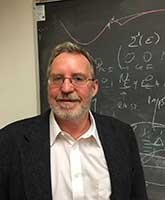非常抱歉,
你要访问的页面不存在,
非常抱歉,
你要访问的页面不存在,
非常抱歉,
你要访问的页面不存在,
验证码:

职称:Director of Biophysics; Warner-Lambert/Parke-Davis Professor of Chemistry and Professor of Biophysics
所属学校:University of Michigan-Ann Arbor
所属院系:Biophysics
所属专业:Biophysics
联系方式:734.764.1146
Understanding the forces that determine the structure of proteins, peptides, nucleic acids, and complexes and assemblies containing these molecules as well as the processes by which the structures are adopted is essential to extend our knowledge of the molecular nature of structure and function. To address such questions, we use statistical mechanics, molecular simulations, statistical modeling, and quantum chemistry. Creating atomic-level models to simulate biophysical processes (e.g., folding of a protein or binding of a ligand to a biological receptor) requires (1) the development of potential energy functions that accurately represent the atomic interactions and (2) the use of quantum chemistry to aid in parameterizing these models. Calculation of thermodynamic properties requires the development and implementation of new theoretical and computational approaches that connect averages over atomistic descriptions to experimentally measurable thermodynamic and kinetic properties. Interpreting experimental results at more microscopic levels is fueled by the development and investigation of theoretical models for the processes of interest that range form atomic level detail to more coarse-grained molecular representations. Massive computational resources are needed to realize these objectives, and this need motivates our efforts aimed at the efficient use of new computer architectures, including large supercomputers, Linux Beowulf clusters, and computational grids. Each of the objectives and techniques mentioned represents an ongoing area of development within our research program.
Understanding the forces that determine the structure of proteins, peptides, nucleic acids, and complexes and assemblies containing these molecules as well as the processes by which the structures are adopted is essential to extend our knowledge of the molecular nature of structure and function. To address such questions, we use statistical mechanics, molecular simulations, statistical modeling, and quantum chemistry. Creating atomic-level models to simulate biophysical processes (e.g., folding of a protein or binding of a ligand to a biological receptor) requires (1) the development of potential energy functions that accurately represent the atomic interactions and (2) the use of quantum chemistry to aid in parameterizing these models. Calculation of thermodynamic properties requires the development and implementation of new theoretical and computational approaches that connect averages over atomistic descriptions to experimentally measurable thermodynamic and kinetic properties. Interpreting experimental results at more microscopic levels is fueled by the development and investigation of theoretical models for the processes of interest that range form atomic level detail to more coarse-grained molecular representations. Massive computational resources are needed to realize these objectives, and this need motivates our efforts aimed at the efficient use of new computer architectures, including large supercomputers, Linux Beowulf clusters, and computational grids. Each of the objectives and techniques mentioned represents an ongoing area of development within our research program.